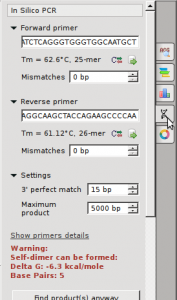Alu’s are unique SINEs that appear in the primate lineage and reveal the lineage and diversification of primates. While retrotransposons can disrupt gene (as in some cases of hemophilia), they often land outside of genes or within introns without effect. One example of a non-disruptive Alu element in humans is found in the location called PV92 on chromosome 16. This element is of the youngest subfamily of Alu, called Ya5.
Since PV92 does not cause any deleterious effects, it can be used as a non-selected marker to illustrate lineage. Some people have an Alu element int his location while others do not. The presence or absence of this marker is viewed as an allele. This lab uses primer that flank the location of the Alu insertion that span 416 bp. If an Alu is present, the amplified DNA will be 300bp larger (the size of an Alu) at 731bp.
Contents
Exercise: In silico PCR of PV92
Forward primer: 5′ GGATCTCAGGGTGGGTGGCAATGCT 3′
Reverse primer: 5′ GAAAGGCAAGCTACCAGAAGCCCCAA 3′
-
- Perform Virtual PCR Informatics Exercise/Discussion
- Find the PCR fragments in Ugene
- Download the sample FASTA file: PV92 sample
- Open the file in Ugene and select option “As Separate Sequences in Viewer”
- Select the “In Silico PCR” button on the far right (double helix button) and insert the primers
- A PCR product should be noted for one of the sequences after pressing “Find Products anyway”
- Click on the second sequence in the viewer and Press “Find Products anyway”
- What are the sizes of each product, if any?
- What does this inform us?
Exercise: PCR genotype PV92 locus
-
- PCR the individual samples
- Pour 2% agarose into casting apparatus in refrigerator
-
- 2 gels per class need to be made → 100ml of TBE with 2g agarose
- add 5μl SYBR safe solution into the molten agarose before casting
- place 2 sets of combs into the gel → at one end and in the middle
- Load DNA ladder and PCR samples
- Run gel at 120V for 30 minutes
- Visualize on UV transilluminator
- Score gels for the presence/absence of the alleles to determine genotype frequency in the class
Tags: cross-cultural communication, life-long learning, breadth of knowledge, cultural awareness



